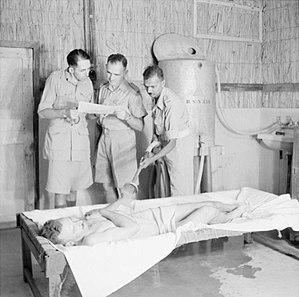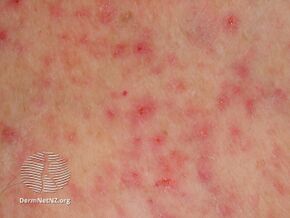Heat illness
| Heat illness | |
|---|---|
| Other names: Heat-related illness, heat stress[1] | |
 | |
| Person being cooled with water spray, one of the treatments of heat stroke. In Iraq in 1943. | |
| Specialty | Emergency medicine |
| Symptoms | Varies by type[1] |
| Types | Mild: Heat rash, heat cramps, heat edema Moderate: Heat syncope, heat exhaustion Severe: Heat stroke[1][2][3] |
| Causes | Environmental heat[4] |
| Risk factors | Other health problems, exercising in the heat, mental illness, alcohol, recently going from a cooler to hotter climate[2][4] |
| Differential diagnosis | Infection, thyroid storm, anticholinergic toxicity, neuroleptic malignant syndrome, serotonin syndrome[5] |
| Prevention | Air-conditioning[6] |
| Treatment | Cooler environment, lying down, wet the skin and clothing, ice packs, fan the person[1] |
| Frequency | Common[5] |
| Deaths | 650 deaths/yr (USA)[6] |
Heat illness is a spectrum of disorders due to environmental exposure to heat.[4] Symptoms vary from clusters of pimples with heat rash; muscle cramps with heat cramps; a brief loss of consciousness with heat syncope; heavy sweating, weakness, headache, and nausea with heat exhaustion; and confusion, seizures, and very high body temperature with heat stroke.[1]
Risk factors include other health problems, exercising in the heat, mental illness, alcohol, and recently going from a cooler to hotter climate.[2][4] Other types of heat injury included by some sources are heat edema and rhabdomyolysis (muscle breakdown).[1][2]
Prevention is by drinking sufficient fluids, replacing lost salts, and limiting time in the heat.[4] Public air-conditioned facilities are important during heatwaves for people who do not have access at home.[6] Treatment may include working in a cooler environment, lying down, wetting the skin and clothing with cool water, ice packs in the groin and armpits, and fanning the person.[1]
Heat illness is common.[5] It occurs more commonly in the old and the young.[2] It results in about 650 deaths per year in the United States and represents about 7% of deaths that occur in the wilderness.[6][2] Males are more commonly affected than females.[6] It is predicted to become significantly more commonly by 2100.[7]
Classification

From least to most severe heat illnesses include:[8][9]
- Heat rash - Skin irritation from excessive sweating.
- Heat edema
- Heat cramps - Muscle pains that happen during heavy exercise in hot weather.
- Heat syncope - Fainting or dizziness as a result of overheating.
- Heat exhaustion - Can be a precursor of heatstroke; the symptoms include heavy sweating, rapid breathing and a fast, weak pulse.
- Heat stroke - Defined by a body temperature of greater than 40 °C (104 °F) due to environmental heat exposure with lack of thermoregulation. Symptoms include dry skin, rapid, strong pulse and dizziness.[10]
Prevention
Prevention includes avoiding medications that can increase the risk of heat illness (e.g. antihypertensives, diuretics, and anticholinergics), gradual adjustment to heat, and sufficient fluids and electrolytes.[11][12]
Epidemiology
Between 2014 and 2017, heat exposure deaths tripled in Arizona (76 deaths in 2014; 235 deaths in 2017) and increased fivefold in Nevada (29 deaths in 2014; 139 deaths in 2017).[13] In 2016 a US government report said that climate change could result in "tens of thousands of additional premature deaths per year across the United States by the end of this century."[14]
Between 1999 and 2003, the US had a total of 3442 deaths from heat illness. Those who work outdoors are at particular risk for heat illness, though those who work in poorly-cooled spaces indoors are also at risk. Between 1992 and 2006, 423 workers died from heat illness in the US.[12]
Exposure to environmental heat led to 37 work-related deaths. There were 2,830 nonfatal occupational injuries and illnesses involving days away from work as well, in 2015.[15] Kansas had the highest heat related injury while on the job with a rate of 1.3 per 10,000 workers, while Texas had the most overall.[15] Due to the much higher state population of Texas, their prevalence was only 0.4 per 10,000 or 4 per 100,000. Of the 37 deaths reported heat illnesses, 33 of the 37 occurred between the summer months of June through September. The most dangerous profession that was documented was transportation and material moving.[15] Transportation and material moving accounted for 720 of the 2,830 reported nonfatal occupational injuries or 25.4 percent.[15] After transportation and material moving, Production placed second followed by protective services, installation, maintenance, and repair and construction all in succession[15]
Heat stroke is relatively common in sports. About 2 percent of sports-related deaths that occurred in the United States between 1980 and 2006 were caused by exertional heat stroke.[16] Football in the United States has the highest rates.[16] The month of August, which is associated with pre-season football camps across the country, accounts for 66.3% of exertion heat-related illness time-loss events.[17] Heat illness is also not limited geographically and is widely distributed throughout the United States.[18] An average of 5946 persons were treated annually in US hospital emergency departments (2 visits/ 100,00 population) with a hospitalization rate of 7.1%.[17] Most commonly males are brought in 72.5% and persons 15–19 years of age 35.6%.[17] When taking into consideration all high school athletes, heat illness occurs at a rate of 1.2 per 100,000 kids.[18] When comparing risk by sport, Football was 11.4 times more likely than all other sports combined to be exposed to an exertional heat illness.[18]
History
Heat illness used to be blamed on a tropical fever named calenture.[19]
See also
References
- ↑ 1.0 1.1 1.2 1.3 1.4 1.5 1.6 "Heat Stress Related Illness | NIOSH | CDC". www.cdc.gov. 18 May 2022. Archived from the original on 13 January 2022. Retrieved 6 July 2022.
- ↑ 2.0 2.1 2.2 2.3 2.4 2.5 Lugo-Amador, Nannette M; Rothenhaus, Todd; Moyer, Peter (2004). "Heat-related illness". Emergency Medicine Clinics of North America. 22 (2): 315–27, viii. doi:10.1016/j.emc.2004.01.004. PMID 15163570.
- ↑ Kenny, Glen P.; Wilson, Thad E.; Flouris, Andreas D.; Fujii, Naoto (2018). "Heat exhaustion". Handbook of Clinical Neurology. 157: 505–529. doi:10.1016/B978-0-444-64074-1.00031-8.
- ↑ 4.0 4.1 4.2 4.3 4.4 "Heat Illness". medlineplus.gov. Archived from the original on 4 July 2016. Retrieved 7 July 2022.
- ↑ 5.0 5.1 5.2 Leiva, DF; Church, B (January 2022). "Heat Illness". PMID 31971756.
{{cite journal}}: Cite journal requires|journal=(help) - ↑ 6.0 6.1 6.2 6.3 6.4 "Heat Related Illness" (PDF). CDC. Archived (PDF) from the original on 25 May 2022. Retrieved 9 July 2022.
- ↑ Mora, C; Counsell, CWW; Bielecki, CR; Louis, LV (November 2017). "Twenty-Seven Ways a Heat Wave Can Kill You: Deadly Heat in the Era of Climate Change". Circulation. Cardiovascular quality and outcomes. 10 (11). doi:10.1161/CIRCOUTCOMES.117.004233. PMID 29122837.
- ↑ Tintinalli, Judith (2004). Emergency Medicine: A Comprehensive Study Guide (6th ed.). McGraw-Hill Professional. p. 1186. ISBN 0-07-138875-3.
- ↑ "Heat Illness: MedlinePlus". Nlm.nih.gov. Archived from the original on 2014-07-04. Retrieved 2014-07-10.
- ↑ "Reducing a Heat Stroke in the Summertime For Seniors". Open Arms Home Care. 2022-05-20. Archived from the original on 2022-07-09. Retrieved 2022-05-30.
- ↑ Lipman, GS; Eifling, KP; Ellis, MA; Gaudio, FG; Otten, EM; Grissom, CK; Wilderness Medical Society (December 2013). "Wilderness Medical Society practice guidelines for the prevention and treatment of heat-related illness". Wilderness & Environmental Medicine. 24 (4): 351–61. doi:10.1016/j.wem.2013.07.004. PMID 24140191.
- ↑ 12.0 12.1 Jacklitsch, Brenda L. (June 29, 2011). "Summer Heat Can Be Deadly for Outdoor Workers". NIOSH: Workplace Safety and Health. Medscape and NIOSH. Archived from the original on December 4, 2012.
- ↑ Flavelle, Christopher; Popovich, Nadja (2019-08-26). "Heat Deaths Jump in Southwest United States, Puzzling Officials". The New York Times. ISSN 0362-4331. Archived from the original on 2019-08-29. Retrieved 2019-08-30.
- ↑ U.S. Global Change Research Program (USGCRP) (2016). "The Impacts of Climate Change on Human Health in the United States: A Scientific Assessment. Section 2.7: Projected Deaths and Illness from Temperature Exposure". health2016.globalchange.gov. Archived from the original on 2019-08-30. Retrieved 2019-08-30.
- ↑ 15.0 15.1 15.2 15.3 15.4 "Work injuries in the heat in 2015 : The Economics Daily: U.S. Bureau of Labor Statistics". www.bls.gov. Archived from the original on 2019-11-18. Retrieved 2019-12-06.
- ↑ 16.0 16.1 Yeargin, SW; Kerr, ZY; Casa, DJ; Djoko, A; Hayden, R; Parsons, JT; Dompier, TP (August 2016). "Epidemiology of Exertional Heat Illnesses in Youth, High School, and College Football". Medicine & Science in Sports & Exercise. 48 (8): 1523–9. doi:10.1249/mss.0000000000000934. PMID 27433959.
- ↑ 17.0 17.1 17.2 Nichols, Andrew W. (2014-09-21). "Heat-related illness in sports and exercise". Current Reviews in Musculoskeletal Medicine. 7 (4): 355–365. doi:10.1007/s12178-014-9240-0. ISSN 1935-973X. PMC 4596225. PMID 25240413.
- ↑ 18.0 18.1 18.2 Kerr, Zachary Y.; Casa, Douglas J.; Marshall, Stephen W.; Comstock, R. Dawn (January 2013). "Epidemiology of exertional heat illness among U.S. high school athletes". American Journal of Preventive Medicine. 44 (1): 8–14. doi:10.1016/j.amepre.2012.09.058. ISSN 1873-2607. PMID 23253644.
- ↑ "Calenture: the free dictionary". thefreedictionary.com. Archived from the original on 2016-01-27. Retrieved 2016-01-26.
External links
| Classification | |
|---|---|
| External resources |